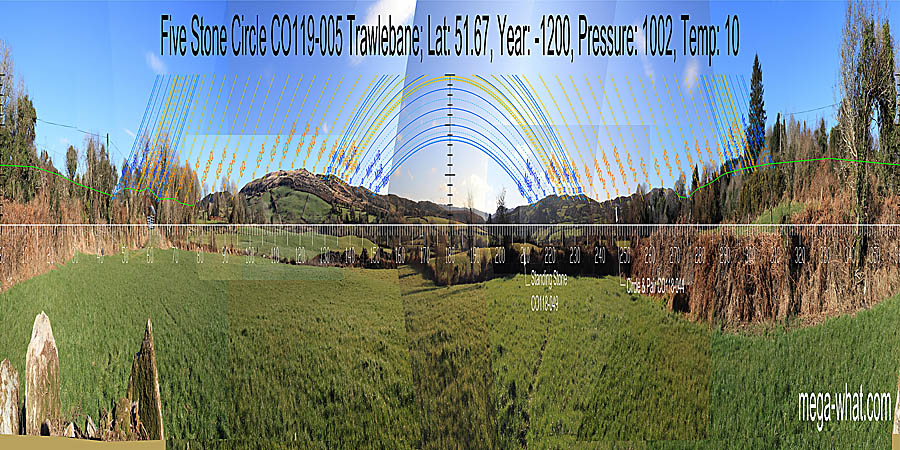 South, in a dip but not the lowest point, is marked by a saddle in nearer ground [Pic].
South, in a dip but not the lowest point, is marked by a saddle in nearer ground [Pic].
North is on a ridge but obscured [Pic].
Green lines approximate hidden horizon segments.
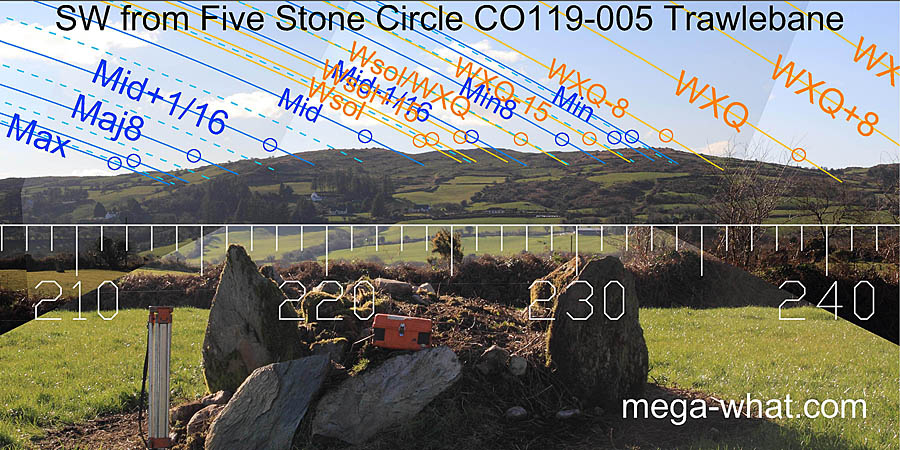 The circle is about 2.4m in diameter and filled with field stones. Its axis indicates a notch in Spratt Hill top that marks the lunar midpoint.
North of that, the ridge terminates in a lower top which marks the minor end of the
lunisticeLunistices are the most northerly and southerly moons of the month. The lunar equivalent of solstices - more.
range. South of the hilltop, at the intersection of its slope with a flatter ridge is a rounded hump that marks the
major standstillLunistice positions vary cyclically over an 18.6 year period but are fairly static for more than a year at either end of the range.
The circle is about 2.4m in diameter and filled with field stones. Its axis indicates a notch in Spratt Hill top that marks the lunar midpoint.
North of that, the ridge terminates in a lower top which marks the minor end of the
lunisticeLunistices are the most northerly and southerly moons of the month. The lunar equivalent of solstices - more.
range. South of the hilltop, at the intersection of its slope with a flatter ridge is a rounded hump that marks the
major standstillLunistice positions vary cyclically over an 18.6 year period but are fairly static for more than a year at either end of the range.
Standing Stone CO118-049 is 175m to the SSW.
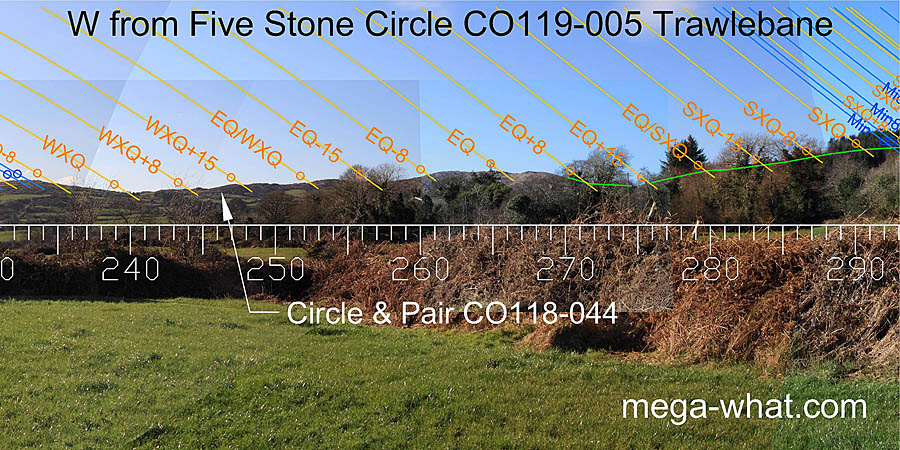 To the west, the winter cross-quarters are in a dip. The land then rises in a useful series of humps and bumps until the equinox occurs on a hilltop.
Beyond that the horizon becomes obscured by trees.
Two kilometres away at about 246° Five-Stone Circle CO118-044 is hidden behind some spruce trees.
To the west, the winter cross-quarters are in a dip. The land then rises in a useful series of humps and bumps until the equinox occurs on a hilltop.
Beyond that the horizon becomes obscured by trees.
Two kilometres away at about 246° Five-Stone Circle CO118-044 is hidden behind some spruce trees.
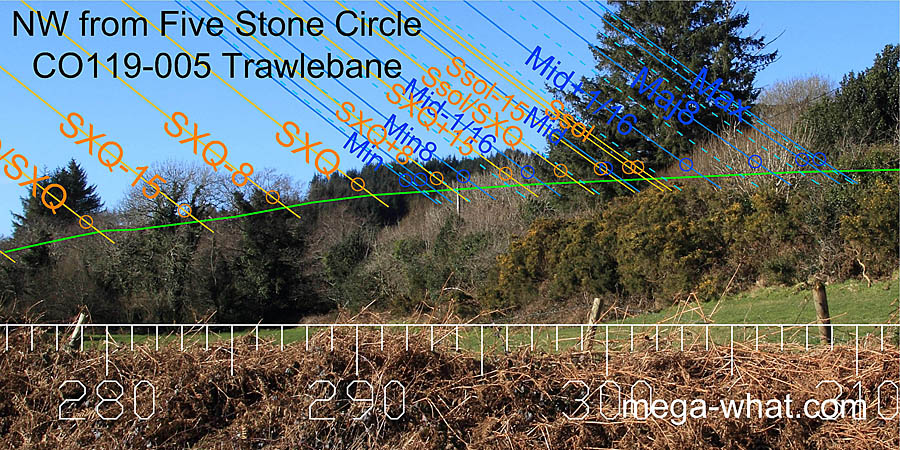 Standing Stone CO118-049, 175m SSW of this Circle is the first of a line of four
(CO118-049, CO118-047, CO118-045 and CO118-09101) joining the two Stone Circles, which together bracket and indicate the summer cross-quarters.
They are all part of a larger complex of stones in this valley.
Standing Stone CO118-049, 175m SSW of this Circle is the first of a line of four
(CO118-049, CO118-047, CO118-045 and CO118-09101) joining the two Stone Circles, which together bracket and indicate the summer cross-quarters.
They are all part of a larger complex of stones in this valley.
The northern horizon is obscured but is a long ridge with the highest point somewhere in the spruce plantation.
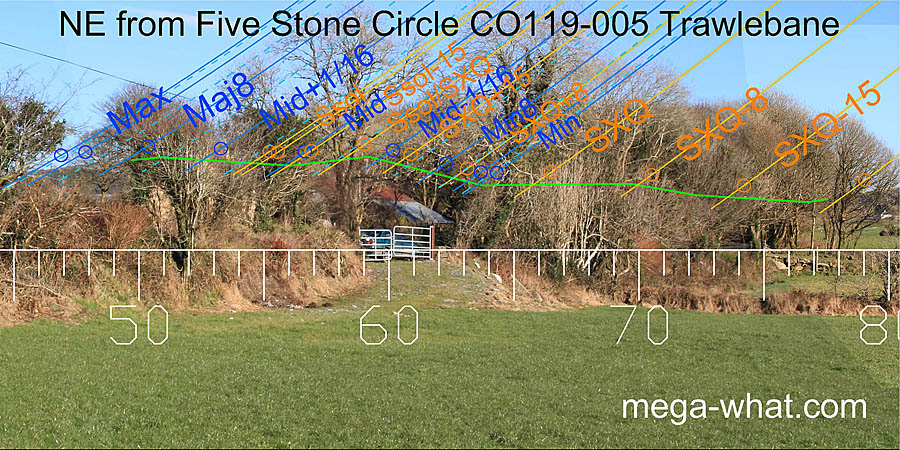 The north-east is also thoroughly obscured by trees but here they conceal a significant block of high ground comprising Glandart hilltop and Mullaghmesha.
Major standstillLunistice positions vary cyclically over an 18.6 year period but are fairly static for more than a year at either end of the range
of the moon occurs on the north slope as may be seen through a gap in the vegetation.
The reverse axis of the circle points slightly north of this.
The north-east is also thoroughly obscured by trees but here they conceal a significant block of high ground comprising Glandart hilltop and Mullaghmesha.
Major standstillLunistice positions vary cyclically over an 18.6 year period but are fairly static for more than a year at either end of the range
of the moon occurs on the north slope as may be seen through a gap in the vegetation.
The reverse axis of the circle points slightly north of this.
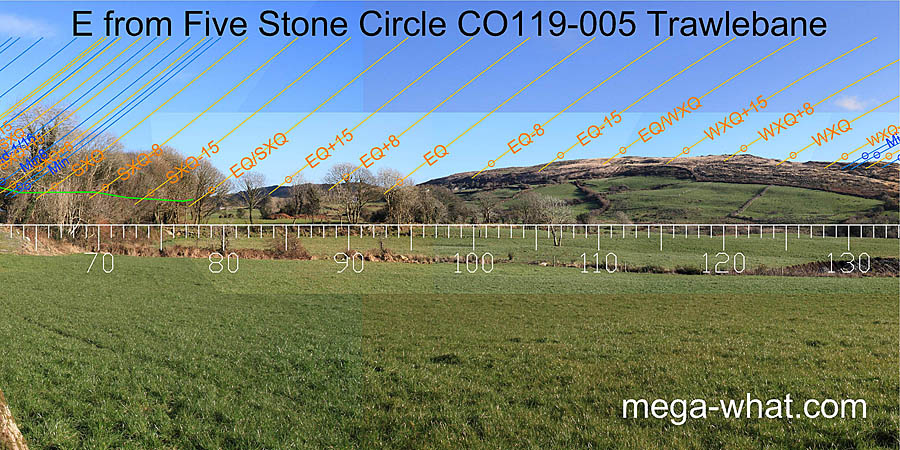 Eastwards the horizon rises as it becomes closer.
The equinox falls in a prominent dip that is known locally as Murdering Glen because it was the hunting ground of a legendary highwayman in times past.
Eastwards the horizon rises as it becomes closer.
The equinox falls in a prominent dip that is known locally as Murdering Glen because it was the hunting ground of a legendary highwayman in times past.
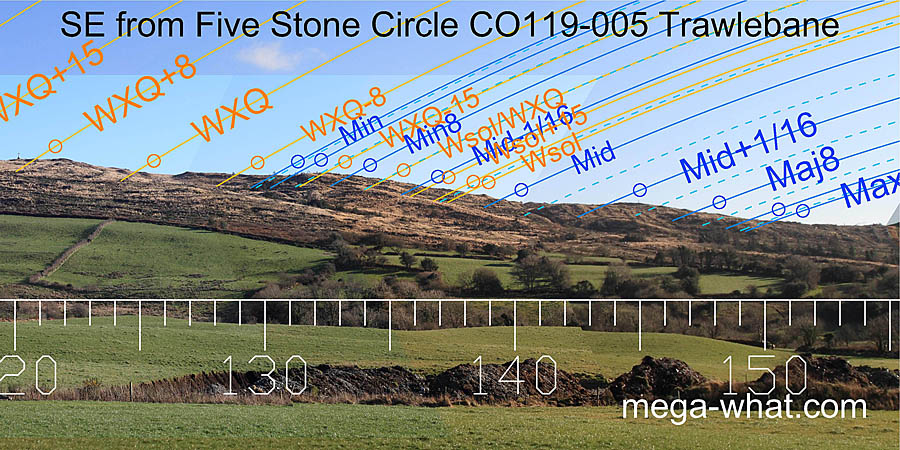 The south-eastern slope has the cross-quarter in a large break near its top, then the minor end of the lunisticeLunistices are the most northerly and southerly moons of the month. The lunar equivalent of solstices - more.
range turns round a top and the midpoint is in a dip. The solstice is indicated by a knoll at the top of a step.
The south-eastern slope has the cross-quarter in a large break near its top, then the minor end of the lunisticeLunistices are the most northerly and southerly moons of the month. The lunar equivalent of solstices - more.
range turns round a top and the midpoint is in a dip. The solstice is indicated by a knoll at the top of a step.
- Standing Stone CO118-049 is 175m to the south-south-west
- Baurgorm Five Stone Circle is 2.1km south-west (246°)
- Inchybegga Five Stone Circle is 1.8km south-east (159°)
References
- Archaeological Survey of Ireland, record details. www.archaeology.ie/archaeological-survey-ireland
- POWER, D. et al. 1992 Archaeological Inventory of County Cork, Volume 1: West Cork. Dublin: Stationary Office. p25, no.82.
